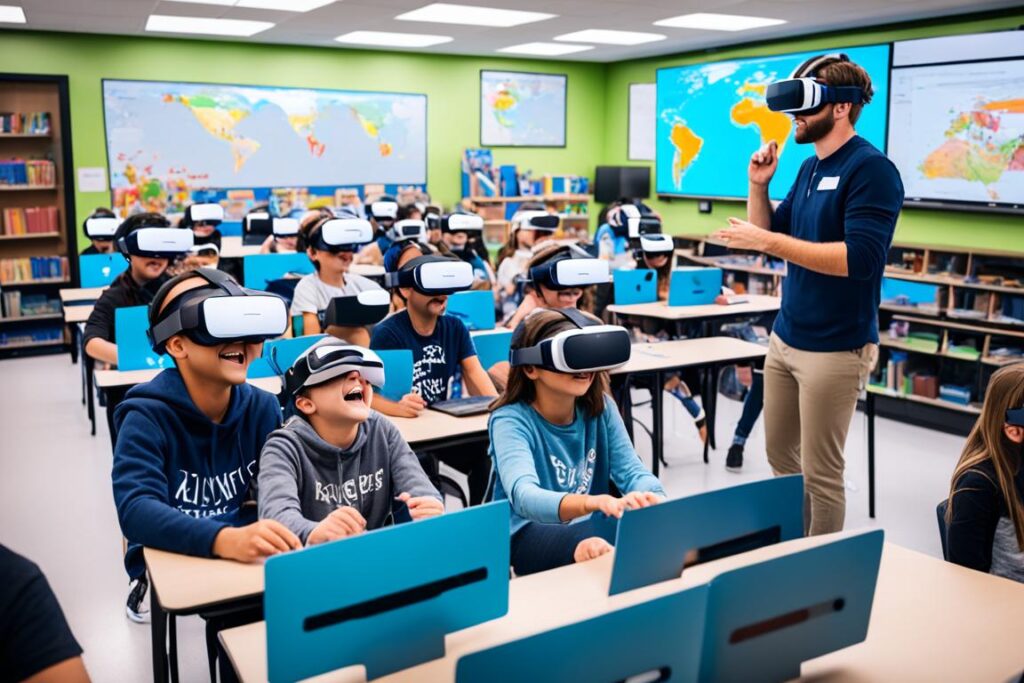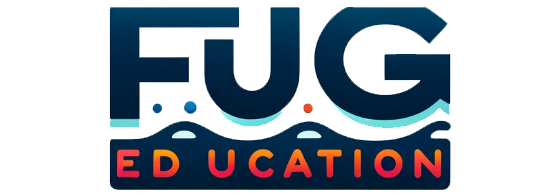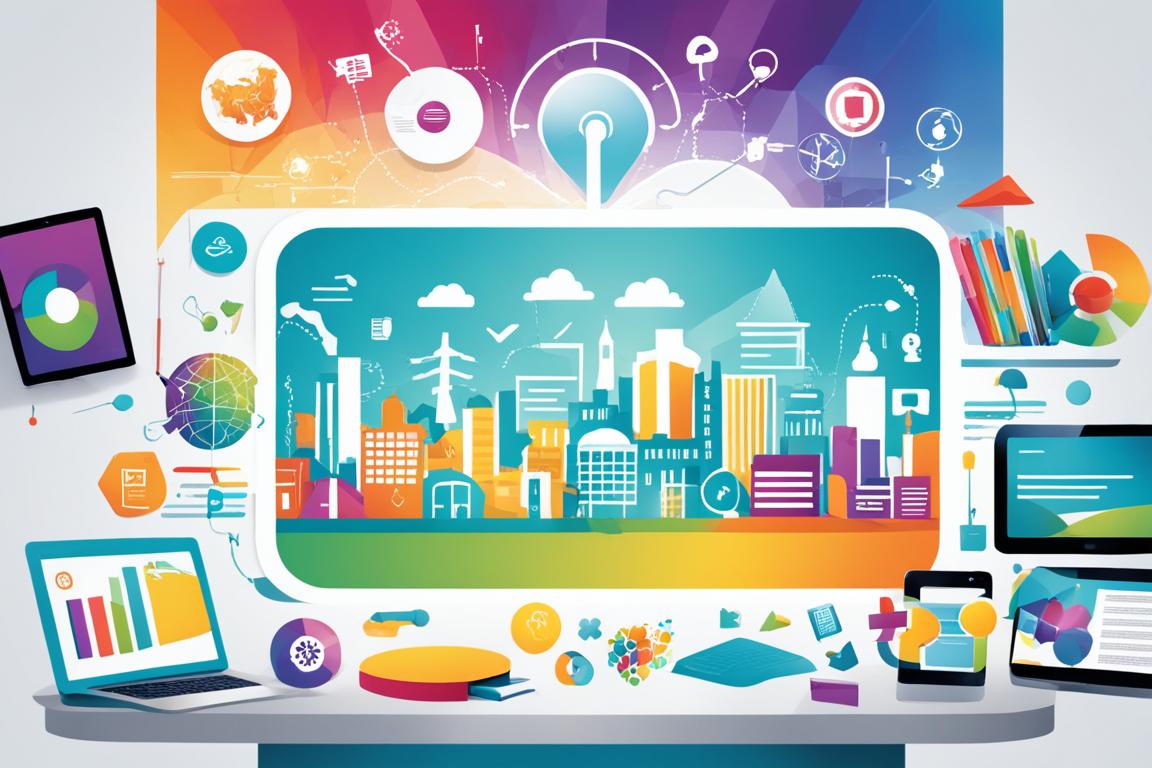Technology has revolutionized education, bridging learning gaps and transforming the way students learn. With the emergence of new educational technologies, such as virtual reality, artificial intelligence, and coding and robotics curricula, classrooms have become more engaging and interactive. These innovations in education technology are reshaping the educational landscape, providing students with more personalized learning experiences and equipping them with the necessary skills for the future. In this article, we will explore the various ways that edtech is enhancing learning experiences and how it is being embraced by educators to bridge the learning gaps that exist in traditional educational approaches.
Key Takeaways:
- Innovations in education technology are transforming traditional educational approaches.
- Virtual reality, artificial intelligence, and coding and robotics curricula are driving the digital transformation of education.
- Edtech enhances learning experiences by providing personalized and interactive learning environments.
- The integration of technology in classrooms equips students with future-ready skills.
- Edtech addresses challenges in education, such as accessibility and inclusivity.
Embracing EdTech to Enhance Learning Experiences
Educational institutions have recognized the power of educational technology (edtech) in enhancing learning experiences for students. Through the integration of innovative technologies, such as virtual reality, artificial intelligence, coding, and robotics, classrooms are being transformed into engaging and interactive spaces.
Virtual Reality in Education
One of the key advancements in edtech is the use of virtual reality (VR) in education. VR technology creates immersive learning environments that enable students to explore new concepts and ideas in a hands-on and experiential way. By transporting students to different locations, historical events, or even imaginary worlds, VR enhances their understanding and retention of information.
The Role of Artificial Intelligence
Artificial intelligence (AI) is playing a vital role in revolutionizing education. AI-powered tools and platforms provide personalized learning experiences tailored to individual student needs. Adaptive learning platforms use AI algorithms to analyze student data and dynamically adjust the learning content and pace. This enables students to receive targeted support and feedback, enhancing their learning outcomes.
Coding and Robotics in Curricula
Coding and robotics are becoming integral parts of curricula, equipping students with essential computational thinking and problem-solving skills. By engaging in coding and robotics activities, students learn how to analyze and break down complex problems, think logically, and collaborate effectively. These skills are in high demand in today’s technology-driven world and are key to preparing students for future careers.
By embracing edtech tools and methods, educators are transforming teaching approaches and creating personalized learning experiences. Through virtual reality, artificial intelligence, coding, and robotics, students are actively engaged in their education, developing crucial skills, and gaining a deeper understanding of the world around them.
Democratizing Education Through Technology
Educational technology has emerged as a powerful tool in democratizing education and breaking down barriers to access. Online learning platforms, in particular, have played a pivotal role in making education more accessible to students worldwide. These platforms provide a wealth of educational resources and opportunities for students to learn at their own pace, regardless of their geographical location or socioeconomic background.
Online Learning Platforms’ Impact
Online learning platforms have revolutionized the way education is delivered and received. They offer a vast array of courses and educational materials that can be accessed anytime, anywhere, using just a computer or mobile device with internet connectivity. This accessibility has greatly expanded educational opportunities for learners of all ages, empowering them to pursue their interests, acquire new skills, and obtain valuable certifications and qualifications. Online learning platforms have truly transformed education into a lifelong learning journey that transcends traditional classroom boundaries.
Global Classroom Initiatives
Another significant impact of educational technology is the rise of global classroom initiatives. These initiatives use technology to connect students from different parts of the world, fostering collaboration and cultural exchange. Through online collaboration tools, students can participate in virtual projects, engage in discussions, and gain insights from diverse perspectives. This international collaboration not only enhances students’ learning experiences but also promotes empathy, tolerance, and understanding among cultures.
In the global classroom, geographical barriers are blurred, enabling students to develop a global mindset and prepare for the interconnected world they will face in their future careers. These initiatives truly exemplify the power of technology in creating a more inclusive and globally connected learning environment.
Personalized Learning: A Tech-Driven Approach
Personalized learning has emerged as a transformative approach in education, enabled by the advancements in educational technology. This tech-driven approach aims to cater to the unique needs and learning styles of individual students, enhancing their educational experiences and outcomes. Two key components of personalized learning are adaptive learning technologies and data analytics, which revolutionize the traditional one-size-fits-all model of education.
Adaptive Learning Technologies
Adaptive learning technologies utilize intelligent algorithms to analyze vast amounts of student data and deliver customized instruction tailored to each learner’s specific needs. Through continuous assessment and adaptive feedback, these technologies can identify knowledge gaps, strengths, and weaknesses in real-time, allowing students to progress at their own pace. By adapting the content, difficulty level, and learning path to suit each student, adaptive learning technologies provide individualized instruction that maximizes learning effectiveness.
Through adaptive learning platforms, students engage with interactive modules, exercises, and assessments that adjust dynamically based on their demonstrated knowledge and performance. This personalized approach fosters student engagement, motivation, and self-directed learning, promoting a student-centered learning environment.
Data Analytics in Customizing Education
Data analytics plays a crucial role in shaping personalized learning experiences. By collecting and analyzing student data, educational institutions gain valuable insights into student performance, learning patterns, and preferences. This data-driven approach allows educators to make informed decisions, customize instruction, and provide targeted interventions.
Data analytics in education helps identify trends, patterns, and correlations in student data, facilitating the identification of personalized instructional strategies and interventions. By leveraging data analytics, educators can optimize curriculum design, instructional delivery, and resource allocation to meet the diverse needs of each student.
Furthermore, data analytics enables early identification of struggling students, allowing for timely intervention and support. By closely monitoring student progress and engagement, educators can proactively address learning gaps and provide individualized assistance, ensuring that every student has the opportunity to succeed.
Collaborative Classrooms: Connecting Learners Worldwide
Technology has transformed classrooms into collaborative spaces where students can connect and collaborate with peers from around the world. Online collaboration tools enable students to work together on projects, share ideas, and engage in cross-cultural learning experiences. Collaborative classrooms promote teamwork, communication, and critical thinking skills, preparing students for the globalized workforce. By connecting learners worldwide, technology is breaking down the barriers of traditional classrooms and creating a more interconnected and inclusive learning environment.
Future-Ready: Preparing Students with Essential Digital Skills
In today’s increasingly digital world, it has become crucial to equip students with the essential digital skills they need to thrive in the future. As technology continues to shape our society and the workplace, it is essential for educators to ensure that students are prepared with the necessary knowledge and abilities to navigate the digital landscape confidently. By integrating technology into the curriculum, educators can help students develop future-ready skills, including digital literacy, problem-solving skills, critical thinking skills, and technology skills.
Enhancing Digital Literacy
Digital literacy is the ability to use and understand digital tools and platforms effectively. It encompasses skills such as internet research, information evaluation, online communication, and digital citizenship. By incorporating technology into the classroom, educators can enhance digital literacy by providing students with hands-on experiences and opportunities to navigate digital resources. Teaching students how to critically evaluate information, discern credible sources, and protect their online privacy are essential components of digital literacy.
Teaching Problem-Solving and Critical Thinking
Problem-solving and critical thinking skills are essential for success in the 21st century. Technology can be a valuable tool for fostering these skills in students. By engaging in technology-rich projects and activities, students can develop their problem-solving abilities by tackling real-world challenges and finding innovative solutions. Technology also provides access to vast amounts of information, allowing students to analyze and evaluate data critically. Moreover, technology enables students to collaborate, communicate, and think creatively, further enhancing their critical thinking skills.
By integrating technology into the curriculum, educators can prepare students for the future by equipping them with the necessary digital skills. This not only ensures that students are well-prepared for the digital age but also empowers them to be active participants and contributors in an increasingly technology-driven society.
Accessibility and Inclusivity: EdTech’s Pivotal Role
In the pursuit of creating an inclusive and equitable education system, technology plays a pivotal role. EdTech has the power to promote accessibility and ensure that all students, regardless of their individual needs or abilities, can fully participate in the learning process. From assistive technologies to language learning software, these innovative tools are breaking down barriers and fostering an inclusive educational environment.
Assistive Technologies in Education
Assistive technologies have revolutionized education for students with disabilities. These technologies, such as screen readers and speech-to-text software, provide valuable support and enable students to navigate the learning materials effectively. By incorporating assistive technologies into classrooms, educators can empower students to overcome their challenges and actively engage in the educational journey.
Language Learning Software and Multilingual Education
Language learning software and multilingual education tools have opened doors for students to develop language skills and embrace cultural diversity. These digital resources offer interactive language learning experiences, allowing students to practice and improve their linguistic abilities in a dynamic and engaging manner. As our world becomes increasingly interconnected, fostering multilingualism through edtech helps prepare students for the globalized society they will enter.
Furthermore, multilingual education promotes cultural understanding and bridges the communication gap between diverse communities. By embracing language learning software, educators can create an inclusive environment that celebrates diversity and nurtures curiosity about different cultures and languages.
Overall, edtech plays a crucial role in promoting accessibility and inclusivity in education. By leveraging assistive technologies and embracing language learning software, educators can empower all students with the tools they need to thrive in a diverse and inclusive learning environment.

Navigating the Challenges of EdTech Adoption
While the adoption of edtech brings numerous benefits, it also comes with challenges that must be navigated. Two significant challenges in this regard are the digital divide and privacy and security concerns in digital learning.
Overcoming the Digital Divide
The digital divide refers to the unequal access to technology and internet connectivity among students. This divide creates disparities in educational opportunities, as students without access to technology may be left behind. Bridging the digital divide is crucial to ensure equitable access to educational resources and opportunities for all students.
Addressing Privacy and Security in Digital Learning
Privacy and security concerns in digital learning are essential considerations to protect student data and maintain a safe learning environment. With the increased use of technology in education, it becomes imperative to have robust policies and measures in place to safeguard sensitive information. Educators and policymakers must address these concerns and prioritize data privacy and cybersecurity in education.
The Digital Transformation of Education Administration
Educational technology is driving a digital transformation in education administration. The integration of edtech in school administration is revolutionizing the way administrative processes are handled, leading to streamlined operations and improved efficiency. Online administrative systems and software are replacing manual and paper-based methods, enabling educators and administrators to focus more on teaching and supporting students.
With the implementation of online administrative systems, tasks such as attendance tracking, grading, and resource management can be carried out effortlessly and with greater accuracy. By automating these processes, educators can save time and allocate more resources to providing personalized attention to students. These systems also enhance data-driven decision-making by providing educators and administrators with valuable insights into student performance, allowing them to identify areas for improvement and implement targeted interventions.
The digital transformation of education administration facilitates seamless communication and collaboration among various stakeholders, including teachers, administrators, parents, and students. Online platforms enable real-time access to information and resources, fostering effective communication and promoting transparency. This level of connectivity ensures that all relevant parties are informed and involved in the educational process, leading to better coordination and support for students.
Furthermore, the adoption of edtech in school administration promotes the use of data-driven decision-making. The availability of comprehensive student data allows educators to analyze trends, track progress, and identify areas where additional support may be needed. By leveraging data analytics, educators can make informed decisions and implement personalized strategies to meet the specific needs of each student.
In summary, the digital transformation of education administration through edtech is revolutionizing traditional administrative processes, making them more efficient and effective. Online administrative systems, streamlined processes, and data-driven decision-making contribute to better outcomes for students and educators alike. By embracing technology, education administrators can focus on what matters most: supporting student success and creating an optimal learning environment.
| Benefits of the Digital Transformation of Education Administration |
|---|
| Streamlined administrative processes |
| Improved efficiency and productivity |
| Enhanced data-driven decision-making |
| Seamless communication and collaboration |
| Personalized attention and support for students |
Advancements in Ed Tech: Interactive and Engaging Tools
Advancements in educational technology (ed tech) have paved the way for the development of interactive and engaging tools that enhance the learning experience for students. These innovative tools leverage technology to create immersive learning environments, fostering student engagement, motivation, and deeper understanding.
Gamified Learning Experiences
One exciting advancement in ed tech is the incorporation of gamified learning experiences. Gamification applies game elements, such as point systems, badges, and leaderboards, to educational contexts. By transforming the learning process into a game, students become active participants, driven by intrinsic motivation to achieve goals and overcome challenges. This approach promotes student engagement and enables them to learn in a fun and interactive way.
Simulations and Interactive Software
Simulations and interactive software are another significant advancement in ed tech. These tools provide students with virtual, hands-on experiences that replicate real-life situations and environments. Through simulations, students can delve into complex concepts, experiment with different scenarios, and observe the consequences of their actions in a controlled and safe virtual environment. This immersive approach enhances critical thinking, problem-solving skills, and deepens understanding.
Interactive software complements traditional teaching methods, allowing students to actively engage with the subject matter. Through interactive educational software, students can explore, manipulate, and interact with digital content, facilitating a deeper understanding of complex concepts. Whether through virtual labs, interactive exercises, or multimedia presentations, these tools provide students with active learning experiences.
A Complete Interactive Tools Table
| Tool | Features |
|---|---|
| Gamified Learning Platforms | Points, badges, leaderboards, challenges, and rewards |
| Virtual Simulations | Realistic scenarios, interactive environments, hands-on experimentation |
| Interactive Educational Software | Digital content exploration, manipulation, and interaction |
As technology continues to advance, the possibilities for interactive and engaging ed tech tools are limitless. These tools capture the attention of students, promote active learning, and create memorable educational experiences. By embracing these advancements, educators can revolutionize the learning journey and equip students with the skills and knowledge needed for success in the digital age.
Innovations in Education Technology: The New Learning Frontier
The field of education technology is constantly evolving, with new innovations and technologies emerging regularly. These innovations in education technology are revolutionizing the way knowledge is shared and acquired, pushing the boundaries of traditional education and transforming the learning experience.
Emerging educational technologies such as artificial intelligence, virtual reality, blockchain, and augmented reality offer unique opportunities for educators and students alike. These cutting-edge ed tech advancements are reshaping the educational landscape, providing transformative and engaging learning environments.
Artificial intelligence, for example, enables personalized and adaptive learning experiences, tailoring education to individual students’ needs and helping them reach their full potential. Virtual reality creates immersive learning environments, allowing students to explore new concepts and ideas in a more interactive and hands-on way.
Blockchain technology ensures the security and transparency of educational records, preventing fraud and providing verifiable credentials. Augmented reality enhances the learning experience by overlaying digital content onto the real world, enabling students to interact with information and objects in a more dynamic and engaging manner.
These futuristic advancements in education are revolutionizing the way students learn, making education more accessible, personalized, and engaging. With the integration of transformative education technology, students are better equipped to develop the skills and knowledge they need for the future.

Educational Equity: Tech as a Catalyst for Change
Technology has the potential to bridge socioeconomic gaps in education and promote educational equity. By providing equal access to educational resources and opportunities, technology can level the playing field and empower marginalized students. EdTech initiatives are driving social change by promoting gender equality in STEM fields and addressing societal inequalities. These efforts aim to create a more inclusive and equitable education system, where every student has an equal opportunity to succeed.
Bridging Socioeconomic Gaps in Education
In many educational systems, students from disadvantaged backgrounds face significant barriers to academic success. Limited access to educational resources, inadequate infrastructure, and socioeconomic factors can create disparities in learning outcomes.
However, technology has emerged as a powerful tool to bridge these gaps. With technological advancements, students from all backgrounds can access quality educational content, collaborate with their peers, and receive personalized support.
“Technology has the potential to level the playing field, ensuring that all students have access to the same opportunities and resources.”
By utilizing educational technology, schools can provide students with digital learning materials, online tutorials, and interactive platforms that cater to their individual needs. Additionally, digital platforms enable teachers to monitor student progress closely, identifying areas where additional support is required.
Promoting Gender Equality in STEM through EdTech
Gender equality in STEM (Science, Technology, Engineering, and Mathematics) fields is a pressing issue. Women and girls are often underrepresented in these domains, and the gender gap persists throughout their educational journey.
EdTech is playing a vital role in promoting gender equality in STEM by providing equal opportunities for all students to explore and excel in these subjects. Through online resources, virtual laboratories, and coding platforms, technology is breaking down traditional barriers and fostering a more inclusive learning environment.
Digital platforms also enable educators to challenge gender stereotypes and introduce diverse role models in STEM fields. By showcasing successful female scientists, engineers, and mathematicians, edtech initiatives inspire young girls to pursue their interests and can help close the gender gap in STEM.
Overall, technology is a catalyst for educational equity and social justice. By leveraging edtech to bridge socioeconomic gaps in education and promote gender equality in STEM fields, we can create a more inclusive and equitable educational system. It is essential to continue investing in digital inclusion and technology for marginalized students to ensure that every learner has an equal opportunity to thrive.
Conclusion
Educational technology, or edtech, is revolutionizing the way students learn and educators teach. By bridging learning gaps, enhancing learning experiences, and preparing students for the future, edtech is transforming education as we know it. The advancements in virtual reality, artificial intelligence, personalized learning, and collaborative classrooms have had a profound impact on the educational landscape.
Embracing these technologies can create more inclusive, engaging, and effective learning environments. Virtual reality immersion provides students with interactive and captivating learning experiences, fostering curiosity and exploration. Artificial intelligence enables personalized learning pathways, catering to each student’s unique needs and preferences. Personalized learning empowers students to learn at their own pace, increasing engagement and retention. Collaborative classrooms connect learners worldwide, promoting teamwork, communication, and cultural exchange.
The future of education holds immense potential for innovative teaching methods and enhanced educational outcomes. As technology continues to evolve, we can foresee even more advancements in edtech that will further transform education. By harnessing the power of technology, we can unlock a world of possibilities for students, equipping them with the skills they need to thrive in the digital age.
In conclusion, edtech is shaping the future of education by providing new tools and approaches that bridge learning gaps, enhance learning experiences, and prepare students for the challenges of tomorrow. The benefits of edtech are undeniable, and its integration into classrooms worldwide is facilitating a transformation in education like never before. As educators and administrators embrace these innovative technologies, students are empowered to achieve their full potential and become lifelong learners.
FAQ
How is technology transforming education?
Technology is transforming education by bridging learning gaps, enhancing learning experiences, and preparing students for the future. It is revolutionizing teaching methods, providing personalized learning experiences, and creating collaborative classrooms.
What are some key advancements in educational technology?
Some key advancements in educational technology include virtual reality, artificial intelligence, coding and robotics in curricula, adaptive learning technologies, data analytics in education, and online collaboration tools.
How does edtech enhance learning experiences?
EdTech enhances learning experiences by creating immersive and interactive learning environments, providing personalized instruction, promoting collaborative learning, and fostering critical thinking and problem-solving skills.
How does technology democratize education?
Technology democratizes education by making it more accessible to students regardless of their location or socioeconomic background, offering online learning platforms and global classroom initiatives, and promoting inclusivity in education.
What is personalized learning, and how does technology support it?
Personalized learning is an approach that tailors instruction to each student’s unique needs and learning style. Technology supports personalized learning through adaptive learning technologies, intelligent algorithms, and data analytics that provide individualized instruction and targeted support.
How does technology promote collaboration in classrooms?
Technology promotes collaboration in classrooms by providing online collaboration tools, facilitating virtual team projects, connecting learners worldwide, and fostering cross-cultural learning experiences.
How does education technology prepare students for the future?
Education technology prepares students for the future by enhancing their digital literacy, teaching them essential technology skills, and fostering problem-solving and critical thinking abilities necessary in a digital age.
How does technology promote accessibility and inclusivity in education?
Technology promotes accessibility and inclusivity in education through assistive technologies for students with disabilities, language learning software, and edtech initiatives that ensure equal access to educational resources and opportunities for all students.
What are some challenges in adopting educational technology?
Some challenges in adopting educational technology include addressing the digital divide to ensure equitable access to technology, and addressing privacy and security concerns in digital learning to protect student data and maintain a safe learning environment.
How does technology transform education administration?
Technology transforms education administration by streamlining administrative processes through online administrative systems, facilitating data-driven decision-making, and providing valuable insights into student performance.
How do interactive and engaging tools impact learning?
Interactive and engaging tools, such as gamified learning experiences and simulations, promote student motivation, participation, and deeper understanding, revolutionizing the learning experience.
What are some innovative educational technologies?
Some innovative educational technologies include virtual reality, artificial intelligence, blockchain, augmented reality, and other emerging technologies that push the boundaries of traditional education and transform the learning experience.
How does technology promote educational equity?
Technology promotes educational equity by bridging socioeconomic gaps in education, providing equal access to educational resources and opportunities, and promoting gender equality in STEM fields through edtech initiatives.
Source Links
- https://elearningindustry.com/the-role-of-technology-in-education-post-pandemic
- https://www.linkedin.com/pulse/how-education-technology-bridging-gap-between-students-teachers-iu48f
- https://www.linkedin.com/pulse/equipping-future-bridging-education-gap-edtech-paradox-alpha

